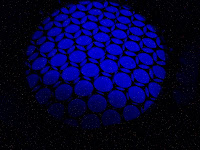

Wikipedia States:Color or colour[1] is the visual perceptual property corresponding in humans to the categories called red, yellow, blue and others. Color derives from the spectrum of light (distribution of light energy versus wavelength) interacting in the eye with the spectral sensitivities of the light receptors. Color categories and physical specifications of color are also associated with objects, materials, light sources, etc., based on their physical properties such as light absorption, reflection, or emission spectra.
Typically, only features of the composition of light that are detectable by humans (wavelength spectrum from 380 nm to 740 nm, roughly) are included, thereby objectively relating the psychological phenomenon of color to its physical specification. Because perception of color stems from the varying sensitivity of different types of cone cells in the retina to different parts of the spectrum, colors may be defined and quantified by the degree to which they stimulate these cells. These physical or physiological quantifications of color, however, do not fully explain the psychophysical perception of color appearance.
The science of color is sometimes called chromatics. It includes the perception of color by the human eye and brain, the origin of color in materials, color theory in art, and the physics of electromagnetic radiation in the visible range (that is, what we commonly refer to simply as light).
So this was my experiment, to produce a nice cobalt blue color, using electromagnetic radiation in the non-visible range (xrays) to produce light in the visible range of 420 nm, that would be a nice kayak deck color, using x-rays and a crystal from a gamma camera. What is known is that a crystal from a Gamma Camera in Nuclear Medicine is made of sodium iodide with Thallium as an activator. If radiation interacts in the crystal it produces light. Blue light actually in the 420 nm range. Is it a nice blue? Well I wanted to find out. I took a crystal from a gamma camera that wasn't being used any longer and took it over to xray to get some xrays shot at it and then photograph the light given off with my camera. What we did was take the crystal to xray and position it on the xray table and took sequential pictures with my camera ta various Kvp settings on the xray machine. We used 4 Kvp settings represented by 2 of the pictures above. The xray room was made totally dark. I stood above the crystal as the xrays were fired at the Sodium Iodide crystal (from Nuc Med) and timed the shot using my Olympus Digital camera based on the techs signal to start. Once the xrays hit the sodium iodide crystal they would absorb the xray energy and convert that energy to light energy in the 420 nm range which shows up to the human eye in the visible spectrum as cobalt blue light which I recorded with my digital camera and which images are represented above and voila a nice "cobalt blue" color for the deck of a kayak. I know I like the color.
2 comments:
Pretty cool Stan, and hi-tech. I'm reminded of a line in the Crowded House tune Fingers of love - "Colour is its own reward".
Tony :-)
Yeah kinda neat Tony and I am sure there are easier ways to see the color we call "cobalt". Usually there are photomultiplier tubes behind the crystal in the camera, about 37 depending on the camera head size. They would detect that blue light we would never see because the camera head is hermetically sealed. So essentially ionizing radiation that we inject into a patient, leaves the patient hits the crystal and the PM tubes detect the light and position circuitry place the dot of one event on a screen propotional to where it occured in the patient. So in essence I just wanted to see what I never normally get to see in the course of my everyday work........blue light baby!!!lol
Stan
Post a Comment